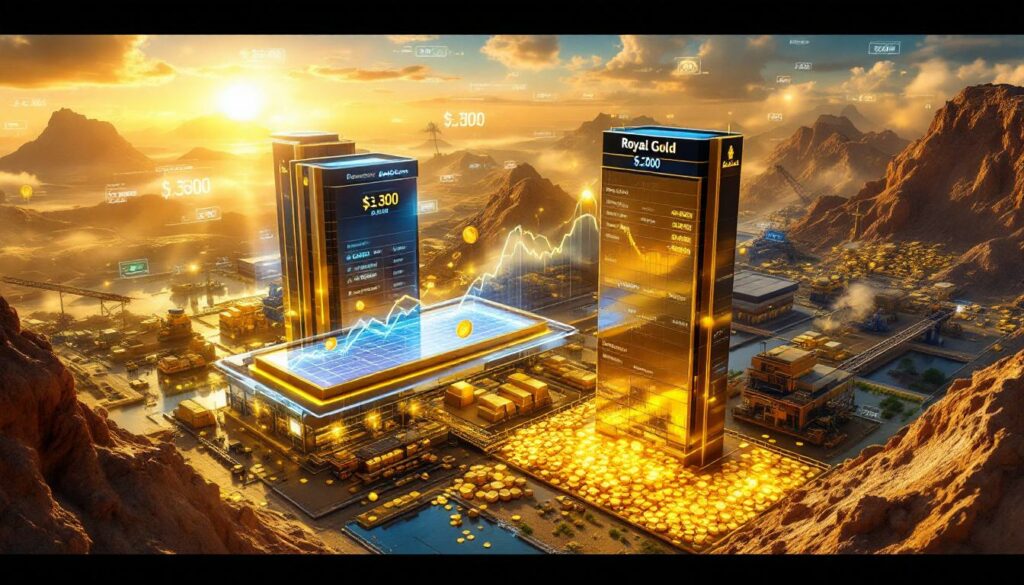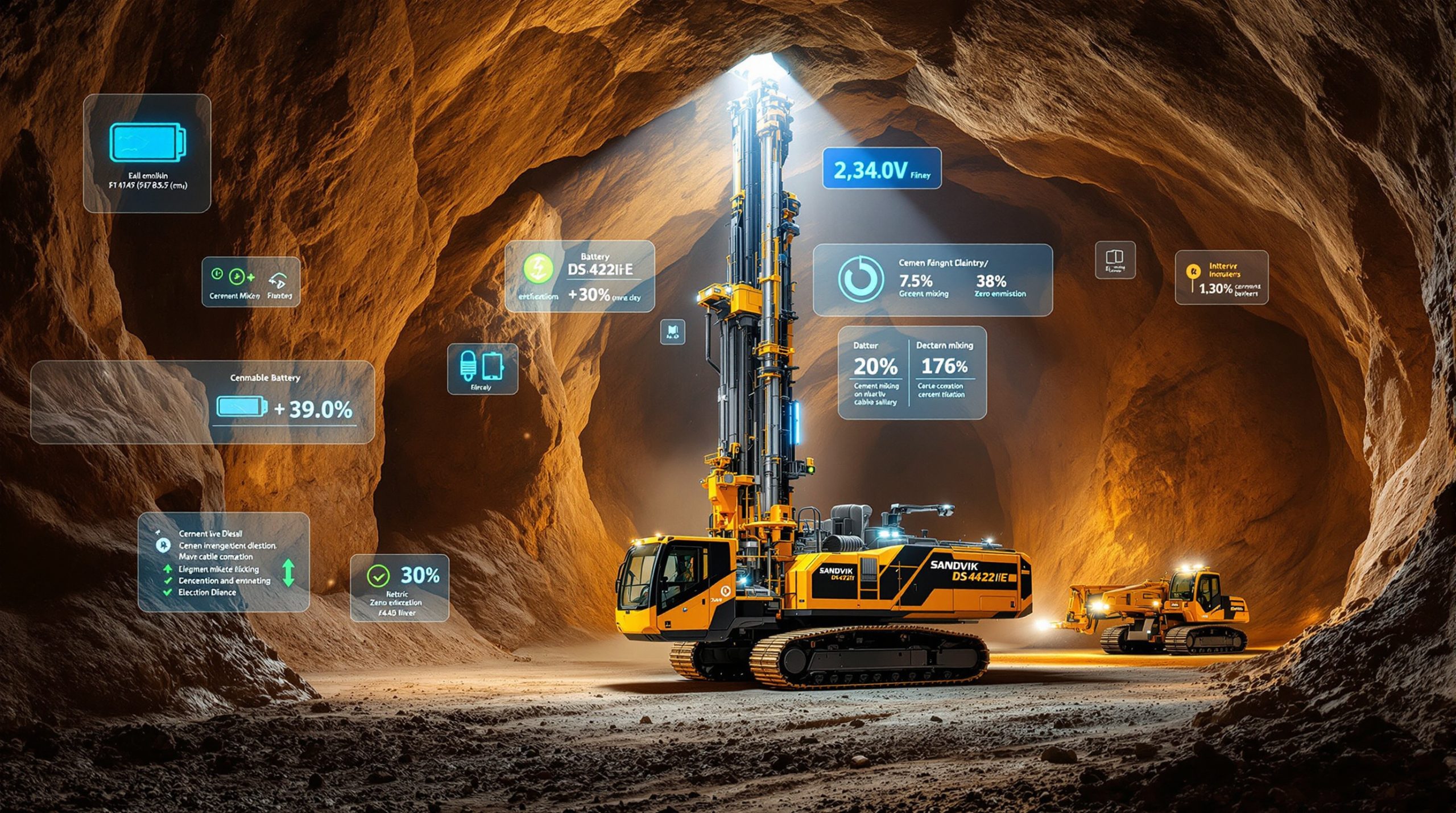Royal Gold's Acquisition of Sandstorm: Reshaping the Mining Royalty Landscape
The $3.5 billion all-stock acquisition of Sandstorm Gold by Royal Gold represents a watershed moment for the mining royalty industry. This transaction, one of the largest in the sector's history, signals a significant shift in how major royalty companies approach growth in an environment of rising precious metals prices and limited acquisition opportunities.
The deal combines Royal Gold's established portfolio with Sandstorm's growth-oriented assets, creating a more diversified royalty powerhouse. For investors in both companies and the broader mining royalty space, this merger highlights important trends that could reshape investment strategies in this specialized sector.
Key Transaction Details
- Deal value: Approximately $3.5 billion all-stock transaction
- Structure: Complete acquisition of Sandstorm by Royal Gold
- Strategic significance: Combines Royal Gold's strong balance sheet with Sandstorm's growth-focused portfolio
- Timing: Announced during a period of gold price strength and increasing market caps for royalty companies
Why Is Consolidation Accelerating in the Royalty Sector?
The Capital Redeployment Challenge
The royalty sector has experienced remarkable growth in recent years, with major players seeing their market capitalizations increase by approximately $30 billion in 2024 alone. This rapid expansion—achieved in just months after taking 40 years to reach the same milestone previously—has created a unique challenge: these companies now generate over $4 billion in annual free cash flow collectively, but face limited opportunities to redeploy this capital effectively.
Traditional royalty deals in the $200-500 million range no longer make sufficient impact on these enlarged businesses. With gold price forecast showing surges from $2,000 to over $3,300 in just 18 months, the search for meaningful growth opportunities has intensified, making large-scale consolidation increasingly attractive.
As one industry expert noted: "It's very difficult to redeploy that amount of capital because the opportunity set again kind of remain the same. And so as those businesses have scaled… all of a sudden M&A makes a lot more sense."
The Mid-Tier Tension Point
The consolidation pressure is particularly acute in the mid-tier segment of the royalty market. As major players seek transactions large enough to meaningfully impact their businesses, mid-tier royalty companies have become prime acquisition targets. This creates what industry experts describe as "tension" in this segment, as these companies must either become acquirers themselves or potentially become acquisition targets.
The Royal Gold-Sandstorm deal has triggered a domino effect, with other major royalty companies likely evaluating similar strategic moves to maintain competitive positioning and growth trajectories. Furthermore, this transaction exemplifies broader mining consolidation trends visible across the resources sector.
How Does the Deal Benefit Royal Gold and Sandstorm Shareholders?
Complementary Portfolio Strengths
From a strategic fit perspective, the transaction combines complementary strengths:
- Royal Gold: Brings a strong balance sheet and established production portfolio
- Sandstorm: Contributes significant embedded growth potential within its asset portfolio
This combination addresses challenges both companies faced individually. Sandstorm had been working through what some analysts called "hangovers" from its aggressive growth phase, while Royal Gold gains access to Sandstorm's growth pipeline at a time when organic growth opportunities are scarce.
As industry observers point out: "You've got Sandstorm which had a lot of growth built into their portfolio. Growth is very difficult to buy today especially when the gold price has gone from 2,000 to $3,300 in 18 months… with Royal in their balance sheet basically they can absorb a lot of the hangovers that kind of Sandstorm was working through."
Shareholder Perspective
For shareholders of both companies, the transaction offers distinct advantages:
- Sandstorm shareholders: Gain exposure to Royal Gold's stronger balance sheet and more diversified portfolio, reducing risk while maintaining exposure to Sandstorm's growth assets
- Royal Gold shareholders: Access to Sandstorm's growth pipeline without having to develop it independently, potentially accelerating Royal Gold's production growth profile
While some Sandstorm shareholders may feel the company sold at a suboptimal time given rising gold prices, the transaction provides immediate scale benefits and eliminates execution risks associated with Sandstorm's development pipeline. In addition, this deal represents a significant milestone in the gold M&A consolidation wave currently reshaping the sector.
What's Driving Gold's Structural Shift from Hedge to Reserve Asset?
The Changing Perception of Gold
A fundamental shift in how global financial markets view gold is underway. Traditionally positioned as a hedge against volatility, inflation, or geopolitical instability, gold is increasingly being viewed as the "de facto global reserve asset." This represents a profound change in perception that has significant implications for gold prices and mining royalty companies.
This shift has accelerated notably in the past six months, with gold overtaking the euro to become the second-largest component of global foreign exchange reserves, now representing slightly over 20% of these holdings.
As one market analyst explains: "Gold has always been viewed… over the last 20 years as kind of a hedge… That's changed… there's been a structural shift where gold is no longer seen as a hedge. It's seen as the de facto global reserve asset."
Central Bank Buying and Geopolitical Factors
Several factors are driving this structural change:
- Weaponization of the dollar: Sanctions and asset freezes have raised concerns about holding dollar-denominated assets
- Tariff uncertainties: Trade tensions have created unpredictability in international financial relationships
- Risk diversification: Countries are reassessing their reserve holdings to reduce concentration risk
If gold continues its trajectory toward becoming the primary global reserve asset, it could potentially need to represent approximately 50% of global reserves, compared to its current 20% level. This would require a significant increase in the gold price, potentially reaching $6,000-$8,000 per ounce according to some industry projections.
"If gold is going to become the global de facto reserve asset… it needs to get to about 50%. I think 50% of global reserves will at some point be made up of gold."
Regional Reserve Disparities
The potential for continued central bank gold purchases is particularly strong when examining regional disparities in gold holdings:
- Western nations: Countries like the US, UK, France, and Germany hold well over 50% of their reserves in gold
- Emerging markets: Nations including China, India, and Brazil maintain gold holdings below 20% of their reserves
This disparity suggests continued strong demand as emerging market central banks work to rebalance their reserve portfolios toward higher gold allocations.
How Are Gold Equities Performing Relative to Gold Prices?
The Sequential Bull Market Pattern
The current gold bull market is following a textbook sequential pattern, with different segments of the market responding at different stages:
- Gold price appreciation: Began approximately 18-24 months ago
- Major royalty companies and producers: First equities to respond with significant price increases
- Mid-tier producers: Currently seeing strong price performance
- Funded developers: Beginning to attract investor interest
- Exploration companies: Typically the last segment to benefit (still awaiting significant price movement)
This sequential pattern is normal for precious metals bull markets, though many investors express impatience when exploration stocks don't immediately follow gold price movements. Consequently, many investors are searching for undervalued gold stocks that haven't yet fully responded to the metal's price surge.
Fund Flows and Investor Positioning
Despite strong performance from gold mining equities, fund flows data reveals an interesting contradiction: the largest gold ETFs (GDX and GDXJ) have experienced record outflows even as their prices have increased significantly.
This suggests that many generalist investors who hold gold equities as a fixed percentage of their portfolios (typically 2-5%) are rebalancing by selling as these positions grow beyond their target allocations. When these outflows eventually reverse, the impact on gold equities could be substantial.
Recent indicators showing inflows into junior miners and silver suggest the market may be approaching an inflection point where broader investor participation begins.
How Is Technology Transforming the Mining Industry?
AI and Automation Revolution
The mining industry stands on the cusp of a technological revolution that could fundamentally transform its cost structure and operational model. AI in mining operations and automation advancements are progressing at an accelerating pace, with potential to dramatically reduce labor requirements and improve productivity.
Within the next decade, mines that currently require thousands of workers could potentially operate with just 30 people, eliminating the need for large camps and underground human presence. This productivity revolution could lead to a period of cost deflation in an industry that has historically struggled with rising costs.
"10 years from now, you probably will be able to put a mine in production with 30 people instead of thousands… You won't need these huge camps. There will be no people that actually go underground and mine."
This technological transformation creates a fascinating scenario where gold prices could continue rising while production costs potentially decrease—expanding profit margins dramatically beyond their current levels of approximately $1,500 per ounce.
Energy Demand Implications
As mining operations become increasingly automated, energy consumption will rise substantially. This shift from human labor to machine operation creates significant implications for energy markets:
- Data centers: Planned AI infrastructure in the US alone is expected to consume approximately 96 gigawatts of energy, equivalent to about 100 new nuclear power plants
- Robotics: The expansion of industrial robotics will further drive energy demand
- Copper requirements: Data centers are projected to require up to 500,000 tons of copper annually, a demand factor not yet fully incorporated into most copper market forecasts
These projections align with observations from technology leaders like former Google CEO Eric Schmidt, who has discussed the enormous energy requirements of advancing AI technologies with policymakers.
Structural Copper Deficit
The combination of traditional demand growth and these new technology-driven requirements is creating a structural deficit in copper markets that could last a decade. With only a limited number of companies capable of developing major copper mines and development timelines of 5+ years, supply constraints appear inevitable.
This supply-demand imbalance could lead to a historic bull market for copper, particularly between 2028 and 2034, when the gap between supply and accelerating demand could be most acute.
What Makes Royalty Companies Attractive Mining Investments?
The Royalty Business Model Advantage
Royalty and streaming companies offer a distinctive investment approach within the mining sector:
- Non-dilutive free carried interests: Royalties provide exposure to mining assets without operational responsibilities
- Perpetual duration: Many royalties extend for the entire life of a mine
- Top-line cash flow: Royalties generate revenue from the top line, reducing exposure to cost inflation
- Protection from dilution: Unlike direct mining investments, royalty interests remain fixed regardless of how much equity the operating company issues
This business model provides investors with mining sector exposure while mitigating many traditional mining risks.
As industry experts explain: "Royalties are non-dilutive free carried interests that go into perpetuity on mining assets that once they're in production, they deliver topline cash flow… it doesn't matter how much equity that the mining company issues from exploration to development to production along the way… the interest that we have in that royalty stays at one or two or 3% all the way through."
Strategic Portfolio Construction
Successful royalty companies focus on three key elements when building their portfolios:
- Tier-one jurisdictions: Concentrating on politically stable regions with strong rule of law (North America, South America, Australia)
- Quality operators: Partnering with major mining companies that have the technical expertise and financial resources to successfully develop and operate mines
- Superior geology: Focusing on proven geological trends with long-term production potential
This approach is particularly important during periods of geopolitical volatility, when resource nationalism and regulatory uncertainty can threaten mining investments in less stable jurisdictions.
Development vs. Production Balance
The optimal balance between producing and development assets is a critical consideration for royalty companies:
- Too much production: Companies with 60-80% of their portfolio in production often struggle with negative growth profiles
- Ideal balance: Approximately 50% in production and 50% in development provides sustainable growth
- Market inefficiency: Development assets are often significantly discounted by the market, creating opportunities for investors who understand their value
How Should Investors Evaluate Royalty Company Investments?
Valuation Considerations
When evaluating royalty companies, investors should consider several key factors:
- Production timeline: Understanding when development assets will begin generating cash flow
- Operator quality: Assessing the track record and capabilities of the mining companies advancing the underlying projects
- Jurisdictional exposure: Evaluating political and regulatory risks in the regions where royalty assets are located
- Gold price assumptions: Analyzing how different gold price scenarios affect the value of the royalty portfolio
A significant valuation disconnect often exists between current market prices and intrinsic value, particularly for companies with substantial development pipelines that are valued using conservative long-term gold price assumptions.
Case Study: High Growth Potential From Development Assets
The potential value creation from development-stage royalties can be illustrated through real examples. One notable case involved a $6 million investment in a pre-resource royalty that now covers 7.4 million ounces of gold, with approximately 120,000 ounces attributable to the royalty holder. Similar assets have been acquired by major companies like Franco Nevada in billion-dollar transactions, highlighting the exponential value growth potential.
This value creation process demonstrates why investors should carefully assess development-stage assets when evaluating royalty companies, rather than focusing exclusively on current production and cash flow.
Growth Financing Strategies
How royalty companies finance their growth significantly impacts shareholder returns:
- Equity financing: Dilutes existing shareholders but may be necessary in early growth stages
- Debt facilities: Non-dilutive financing that becomes available as cash flow increases
- Accretive acquisitions: Disciplined transactions where the value acquired exceeds the cost of capital
As royalty companies mature, their ability to access credit facilities and other non-dilutive financing options typically improves, enhancing their ability to make larger, more impactful acquisitions without significant shareholder dilution.
What's Next for the Mining Royalty Sector?
Continued Consolidation
The Royal Gold takeover of Sandstorm likely represents the beginning of a broader consolidation trend in the royalty sector. With major players generating substantial free cash flow and seeking meaningful growth opportunities, additional acquisitions of mid-tier royalty companies appear probable.
As one industry observer noted: "The Royal Sandstorm transaction was was a bit of a domino, if you will, that that fell, that, you know, I think will increase kind of how these larger companies are kind of looking at the space and the opportunities that are available."
This consolidation trend creates both opportunities and challenges for investors:
- Potential takeover premiums: Mid-tier royalty companies may trade at higher valuations due to acquisition potential
- Scarcity value: As the number of independent royalty companies decreases, remaining players may command premium valuations
- Scale advantages: Larger royalty companies typically enjoy lower costs of capital and greater deal access
Evolving Investment Landscape
The mining royalty sector is transitioning from a niche investment category to a more mainstream allocation within precious metals portfolios. As gold continues its structural shift toward reserve asset status, royalty companies offer investors a lower-risk entry point to gain exposure to this trend.
For investors considering royalty investments, understanding the development pipeline and growth strategy of each company becomes increasingly important as the sector matures and consolidates. The Royal Gold-Sandstorm acquisition forms part of this broader transformation, creating a more concentrated industry with fewer but larger players.
FAQ: Royal Gold-Sandstorm Acquisition and Mining Royalty Investments
What makes the Royal Gold-Sandstorm deal significant for the mining sector?
The $3.5 billion transaction represents one of the largest deals in mining royalty history and signals a new phase of consolidation in the sector. It demonstrates how major royalty companies are responding to the challenge of deploying substantial cash flows in a limited opportunity environment.
Why are royalty companies considered lower-risk mining investments?
Royalty companies provide exposure to mining without operational responsibilities or direct exposure to cost inflation. They maintain fixed percentage interests regardless of how much equity the operating company issues, and they typically build diversified portfolios across multiple assets and jurisdictions to mitigate risk.
How does the gold price affect royalty company valuations?
Gold price movements directly impact royalty company revenues and valuations. However, most analyst models currently use long-term gold price assumptions ($2,400-2,500) significantly below current spot prices ($3,300+), creating potential valuation upside if higher prices persist.
What factors should investors consider when evaluating royalty
Ready to Spot the Next Major ASX Discovery?
Gain an edge in your investing with Discovery Alert's proprietary Discovery IQ model, which instantly notifies subscribers of significant mineral discoveries on the ASX. Discover why historic mineral discoveries can generate substantial returns by visiting Discovery Alert's dedicated discoveries page and start your 30-day free trial today.




